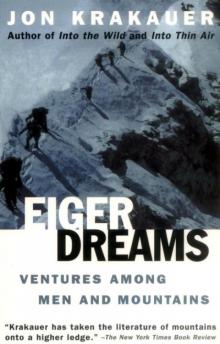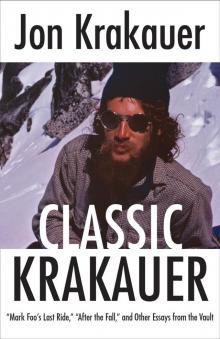- Home
- Jon Krakauer
Classic Krakauer Page 2
Classic Krakauer Read online
Page 2
Climbing the stairs to his cramped second-floor apartment, Clark grabs a pair of binoculars and heads out to the deck. By standing in one corner and leaning over the railing, he can look across the Cabrillo Highway and see a black slice of ocean, drawing an unobstructed bead on Mavericks, five miles up the coast. Squinting through the 10×50 lenses, every few minutes he observes a spume of whitewater erupt high over the sawtoothed cluster of sea stacks at the tip of Pillar Point.
“The swell is coming up,” Clark remarks, his voice betraying an uncharacteristic trace of excitement. “Mavericks will probably go off this afternoon on the minus tide.”
The outer reef at Mavericks squats 21 feet below the ocean’s surface, a mesa of submerged rock sloping abruptly out of deep water. Swells smaller than 10 or 12 feet roll right over the reef without even breaking. But whenever a cell of concentrated low pressure slides down the winter storm track and starts pushing fat, long-interval ground swells ahead of it, Clark keeps his ear glued to his NOAA weather radio for the buoy reports. As the swells come pulsing ashore, the first thing they hit after 2,000 miles of open ocean is Mavericks. Rocketing up the front of the reef like a skier flying off a jump, wave after wave gets launched to astonishing heights.
California is said to be home to more than a million surfers. Why, then, did it take so long for any of them to realize that some of the biggest waves on the planet broke right under their noses? It’s not as though Clark tried to keep Mavericks secret. “I wanted someone to surf with,” Clark says. “I told a lot of people that Mavericks was a world-class wave, but coming from someone like me it didn’t mean anything.”
There are some kick-ass surfers in San Francisco, and even more in Santa Cruz, but they were blinded by their provincialism. At the time, it was simply inconceivable to the big dogs of Ocean Beach and Steamer Lane that an unknown surfer from a backwater like Half Moon Bay could have discovered a new wave worthy of their attention.
It wasn’t until 1990 that outsiders finally started to sit up and take notice of Mavericks. On January 22, a northwest swell of historic dimensions came ashore up and down the California coast. Jeff Clark had driven into the city to work on a construction project, but when he heard the buoy reports coming over the weather radio, he fled the job site and headed immediately to nearby Ocean Beach. There, in the parking lot, he ran into two well-known Santa Cruz surfers, Dave Schmidt and Tom Powers.
The surf at Ocean Beach had redlined and gone off the scale. Unrideable 30-foot closeout sets were pounding the outer reef with extraordinary violence. Paddling out looked suicidal. Clark told the others that he knew a place where the waves would be even bigger, and perfectly shaped. Powers and Schmidt were skeptical, but followed Clark down to Half Moon Bay.
Clark led them up to a bluff north of Pillar Point and pointed out Mavericks just as a set thundered through. “Dave’s jaw dropped,” remembers Clark, “and he goes, ‘Oh my God! That’s Waimea!’ Then he starts pacing back and forth, back and forth, looking out at the waves, saying, ‘That’s huge! I don’t believe what I’m seeing! That’s Waimea!’” The two newcomers nervously paddled out with Clark. Before the day was over, Schmidt had ridden six waves, Powers caught two, and both men were awed by Clark’s performance.
At one point Clark fell as he dropped into a yawning barrel, got crushed by the lip when the wave collapsed, and was held down so long he wondered very seriously if he would have enough breath to make it back to the surface. At the conclusion of the session, everyone was still alive, though, and by the time they left the water, the Santa Cruz surfers were believers.
Over the next two winters, many of the boldest, baddest surfers in California showed up to see if Mavericks was for real. Of those who had also surfed Waimea, most agreed that the California wave broke as big and as thick as anything on the North Shore—and that mistakes at Mavericks are apt to have much more serious consequences. The water is 30 degrees colder than in Hawaii, sapping strength, cramping muscles, significantly reducing the length of time one can hold one’s breath. And the necessity of wearing a restrictive, buoyant wetsuit makes it harder to dive under waves in the impact zone.
The scariest thing about Mavericks, though, is the rocks. The outside peak breaks in such a way that any surfer who blows the drop and eats shit early is very likely to get flushed into the boneyard—a jumble of jagged truck-size boulders, against which he will be brutally pounded by each incoming wave.
Clark, who has paid some stiff dues of his own in the boneyard, says solemnly, “Before you paddle out, you need to think real carefully about the worst-case scenario, and then ask yourself if you’re ready to deal with it. Mavericks punishes mistakes more severely than other waves. I’ve seen some bad things happen out there.”
* * *
—
After flying all night from Honolulu, Ken Bradshaw steered the rental car into the rutted beach parking lot at Pillar Point, and he and Mark Foo climbed stiffly out into the morning sun. They were an unlikely looking pair: built like a tight end, with chiseled All-American features, Bradshaw towered over the 5-foot-8-inch Foo, who had the imperturbable face of a Confucian priest. The fact that they had come to Mavericks as close friends was perhaps even more unlikely, given their long and often bitter rivalry.
At thirty-six, Foo was the younger of the two by five years. He still had the taut physique of a flyweight boxer, but the flesh beneath Foo’s chin was beginning to slacken, and the skin around his eyes was deeply furrowed. Twenty-six years in the surf was starting to take its toll.
Born in Singapore to parents of Chinese descent, Foo spent most of his childhood in greater Washington, D.C., where his father worked for the U.S. Information Agency. He didn’t learn to surf or even swim until the family moved to Hawaii when he was ten, but once introduced to the sport, he resolved to make surfing the whole of his existence.
In 1970, Foo’s father was posted back to Washington and the family resettled in suburban Maryland, a move the headstrong twelve-year-old could not abide. Two years after arriving on the East Coast, much to his family’s dismay, Foo ran off to Florida to make his mark as a surfer. “Good Chinese boys did not aspire to be surfers,” says SharLyn Foo-Wagner, Mark’s older sister. “My mother would have preferred he had become a lawyer or a doctor, like our brother, Wayne.”
The three Foo children grew up comfortably in a family whose values were more mainstream American than traditional Chinese, according to SharLyn. “Our dad was your basic Middle American, detached, workaholic father. Our mom was strong-willed, independent, a feminist from way back.” Wherever it came from, she says, the Foo kids “were all super intense from an early age.”
By the time he was seventeen, Mark had found his way to the North Shore of Oahu, the white-hot nexus of the surfing universe, where he immersed himself in the tournament circuit. Initially, his results were promising, but in 1982, having climbed no higher than 66th in the world professional rankings, he was forced to accept that he would never be a star in that arena.
In what proved to be a stroke of brilliance, Foo decided to abandon the pro tour and concentrate instead on getting his image into print, an enterprise for which he turned out to have rare talent. By establishing a close, symbiotic relationship with the top surf photographers, Foo got his picture on the cover of the two major surfing magazines half a dozen times—more often than any of the world champions who’d surfed circles around him on the contest circuit.
His ubiquitous presence in magazines and videos and on television earned him promotional contracts from several surf-related companies, who paid Foo modest sums to be a human billboard for their products. At one point, he even landed a sponsorship deal with Anheuser-Busch, but Foo never got rich. Because he was a freelancer, operating outside the structure of the pro tour, he seldom cleared more than $30,000 annually. But it gave him the means to surf whenever and wherever he wanted, and that was sufficient to win the lasting enmity of envious associates.
Other surfers heaped op
probrium on Foo for his single-minded pursuit of publicity—he didn’t surf, they groused, unless the cameras were pointed his way—but he remained remarkably unaffected by the criticism, and continued his quest for surfing glory with unabashed enthusiasm. “Yeah, bruddah Mark loved to have his picture taken,” chuckles Dennis Pang, one of Foo’s oldest and closest friends. “He caught a lot of shit for it, but it was like water off a duck’s back.”
In 1983, Foo surfed Waimea Bay for the first time. Unfazed by the bay’s mythic reputation, he attacked the enormous waves with a bravado that forced the old guard to take grudging note. In January 1985, Foo took off on a Waimea wave said to be in excess of 60 feet—bigger than anything ever ridden. He dropped off the overhanging ledge, immediately tumbled into the water, and was smothered by the full force of the wave. The impact of the falling lip snapped Foo’s board and worked him over like a rag in a wringer, but he popped to the surface unharmed and was quickly plucked from the impact zone by a rescue helicopter.
Even though he hadn’t even come close to making the wave, Foo wasted no time in sending accounts of the attempt to magazines around the world, and when these articles were published, they cemented his reputation as a big-wave demigod. In an interview soon thereafter, Foo suggested, “In terms of performance, I don’t think anyone surfs Waimea better than I do.”
Ken Bradshaw, the reigning king of Waimea at the time, didn’t share this opinion. He had been surfing Waimea for nine years before Foo ever dipped a toe in the bay, and the younger surfer’s presumptuousness, his braggadocio—his lack of respect—tweaked Bradshaw. Foo lived just down the Kam Highway from Bradshaw, and the two surfers encountered each other often, both in and out of the water. As Foo’s meteoric rise continued, those encounters became more and more strained.
The nadir in their relationship occurred in 1987, on the morning of a major surf contest at Sunset Beach. During the warm-up period before competition got under way, according to Pang, “Mark kept dropping in on Bradshaw, stealing his waves, and finally Kenny went ballistic. He went after Mark in the channel and started beating him up, dunking him underwater, holding him down. Ken didn’t really hurt Mark, but he embarrassed him in front of all the best surfers in the world. When Mark came in, he called me right away and told me how upsetting it was. He got over it really fast, though. A couple of days later it was like nothing had ever happened. Mark just didn’t let that kind of stuff bother him.”
A corollary of Foo’s unwavering drive was that he was relentlessly, obdurately optimistic. He was convinced it was his destiny to achieve greatness on giant waves. When things got hairy out there, his belief in fate allowed him to maintain a sense of clarity and inner calm. Foo was a religious man; in raging surf—as nowhere else—he felt the rampant presence of the almighty, so close he could taste it in the back of his throat.
Although Foo was monomaniacal and self-absorbed, when it suited him he could be extremely personable, even gregarious. There was something winning about his fervor, his childlike enthusiasm. At least five people considered him their best friend. “You either really liked Mark,” says SharLyn, “or you really didn’t like Mark. Nobody was indifferent.”
For all the derring-do he exhibited in the water, Foo never quite fit the macho cut of the big-wave brotherhood. He was way too willing to discuss his innermost feelings, to bare his emotional underbelly. He wasn’t afraid to get touchy-feely. Women fell for Foo hard and often. He showered his sister and mother with earnest, mawkish letters. “Mark and I were so tight,” SharLyn acknowledges, “that some people thought we had a kind of weird relationship.”
The week before he flew to Mavericks, Foo got engaged to twenty-eight-year-old Lisa Nakano. “He was really in love with Lisa,” says Allen Sarlo, one of Foo’s closest friends. “And his mom approved of her, which was of major importance to Mark.”
Sarlo grows silent for several seconds, then says, “What makes this whole thing kind of heavy is that his older brother, Wayne, died two years ago, just after finishing medical school, and his dad died about three years ago. And recently Mark wrote a letter to his mom telling her that he loved her so much he didn’t think he could ever live without her, that he wanted to die before she did. Mark’s death has been really devastating to her.”
* * *
—
By the time they got their boards out and wetsuits on, it was after nine A.M. when Foo and Bradshaw stroked through the shore break toward the Mavericks lineup. Given the vitriol that had flowed between them over the years, some were taken aback to see the two surfers paddling out together, but their friendship was genuine, insists Dennis Pang: “It wasn’t just on the surface. About eight months before Mark died, he and Kenny became real friends.”
Last summer Foo explained to a British television crew that he and Bradshaw had “gotten past” their differences, thanks to a bond based on the singular intensity of their shared calling: “We’ve experienced things that nobody but he and I have ever done.”
Acquaintances credit the rapprochement primarily to the mellowing of Bradshaw. After two decades of proving his mettle at the bay, his place in the hallowed Waimea pantheon was secure. Comfortable in his emerging role as a respected elder of the big-wave fraternity, Bradshaw no longer felt the need to go one-on-one with every swaggering young turk who paddled out. He finally seemed able to accept Foo for who he was, warts and all; Bradshaw found himself reacting with amusement to quirks of Foo’s personality that would have triggered apoplectic rage just a few years before.
The previous spring, Foo and Bradshaw had surfed a secret North Shore reef together, a spot called Outside Alligators that Bradshaw discovered and pioneered. “We got some exceptional waves out there,” Bradshaw reminisces. “And the place was completely private. Then, after what Mark claimed was maybe the best surf session of his life, he came right in and made, like, thirty phone calls, and suddenly the whole world knew about it. The next time I went out, fifteen guys were there.
“While he was making those calls, I was saying, ‘Mark! Put the damn phone down! No one else has to hear about this spot. We can keep enjoying it by ourselves.’ But he never saw it like that. He had to share everything with the world.” Bradshaw erupts into a deep, ambivalent laugh. “That’s just the way Mark was: high profile all the way.”
December 23 marked Foo’s first visit to Mavericks, though not Bradshaw’s. He’d flown over on several previous occasions, but, he says, “My timing was always a little off. I kept missing the really big days.”
Bradshaw had in fact just been to California six days earlier. He spent part of Saturday, December 17, surfing Mavericks in mediocre conditions, then jumped on a plane and flew back to Hawaii the following morning after hearing that a giant swell was predicted for the North Shore. “Not waiting around a little longer in California was a huge mistake,” Bradshaw dolefully concedes. “One of the all-time big mistakes I’ve ever made.”
Even as Bradshaw’s jet was hurtling toward Honolulu, an intense 934-millibar low had spun down out of the Gulf of Alaska and stalled off the California coast, commencing a week of the largest, most perfect waves anyone in the state had seen in decades, maybe ever.
“Monday the nineteenth, Mavericks was off the chart,” says Mark Renneker, a San Francisco physician who at forty-three is an eminent figure in that city’s surfer community. “Wednesday was even bigger.”
Jeff Clark, Renneker, a rising star named Evan Slater, a hot Santa Cruz surfer named Peter Mel—everyone present that week knew they were witnessing something momentous. Set after set, somebody would catch the wave of his life. A sixteen-year-old kid from Santa Cruz took off on a wave estimated to be at least 50 feet high, a deed that would put him on the cover of Surfer. “Jay Moriarity,” the tag line proclaimed, “drops into history at Mavericks.”
“When I called Doc Renneker from Oahu and heard what I’d missed,” says Bradshaw, “I turned into a basket case.” He and Foo jumped on the red-eye and landed in San Francisco as the
sun came up Friday morning, hustled out to Mavericks, and were greeted with the news that the surf had gone down overnight. The swell had turned sporadic. Few of the waves were breaking bigger than 25 feet—surf Hawaiians would call 12 to 15 feet.
A big set would steamroll through now and then, however, and the action was pitched among the fifteen surfers jockeying for the waves. The sudden arrival of Foo and Bradshaw cranked up the intensity even higher. “It was a circus out there,” says Renneker. “You had these boatloads of photographers, the helicopter, people on the cliffs—and a gaggle of the world’s best surfers at Mavericks for the first time. No one had to be told this was a historic day. A good showing in front of all those cameras could make a career. There was incredible pressure to perform.”
“The crowd was almost in a frenzy,” Clark concurs. “Guys were pushing it maybe a little too far.” In the old days, before Foo taught everyone the value of a dramatic photograph, a more conservative attitude prevailed in big waves. Wiping out was considered kook behavior, not to mention dangerous. But the proliferation of sponsorship contracts based on photo incentives changed all that. Because taking off late and deep—down the steepest, most concave part of the wave—creates the most spectacular pictures, ambitious surfers are strongly motivated to hang it out farther and farther, and the consequences be damned.
“As long as you make the drop,” muses Bradshaw, “the photographers don’t give a shit whether you stay on your feet and actually make the wave. All they want is those three killer shots down the face.” That Friday at Mavericks, he says, “Most guys were taking off ridiculously deep for the cameras, and there were some nasty wipeouts as a result.”

 Into the Wild
Into the Wild Into Thin Air
Into Thin Air Under the Banner of Heaven: A Story of Violent Faith
Under the Banner of Heaven: A Story of Violent Faith Eiger Dreams: Ventures Among Men and Mountains
Eiger Dreams: Ventures Among Men and Mountains Three Cups of Deceit: How Greg Mortenson, Humanitarian Hero, Lost His Way
Three Cups of Deceit: How Greg Mortenson, Humanitarian Hero, Lost His Way Under the Banner of Heaven
Under the Banner of Heaven Missoula
Missoula Classic Krakauer
Classic Krakauer